The Primal Teen
What the New Discoveries About the Teenage Brain Tell Us About Our Kids
by Barbara Strauch
Reviewed by Michael Reist
 Teens
are not lazy. They are in fact the most sleep-deprived members of society!
The fast-growing teenager is up at 6 a.m. to catch the bus, works till
11 p.m. at McDonald's and gets to bed between midnight and 1 a.m. Teens
are not lazy. They are in fact the most sleep-deprived members of society!
The fast-growing teenager is up at 6 a.m. to catch the bus, works till
11 p.m. at McDonald's and gets to bed between midnight and 1 a.m.
Meanwhile, research clearly shows that teens need at least nine hours
of sleep - more than adults and younger children - and that their biological
clocks are programmed for staying up late and sleeping late. Schools that
have tried later start times consistently report higher academic achievement
and fewer behaviour problems.
In this book Barbara Strauch offers a range of similarly relevant discoveries
regarding the teenage brain. The findings have important implications
for parents and teachers.
For example, researchers find that adolescent risk-taking behaviour is
chemically based. Thrills release "feel good" dopamine, which
is at low levels during this period. In addition, the frontal lobes of
the brain, which are responsible for judgement and planning, are undergoing
a restructuring that begins at the onset of puberty and does not finish
until as late as 20. All of which makes for a fast car with no brakes.
As Strauch notes, parents and teachers have a role to play in helping
teens know their limits - being their frontal lobes for them, as she puts
it. Several researchers advocate a greater range of sanctioned risk-taking
activities, suggesting teens could be sent out to the edge in socially
constructive ways rather than indulging in reckless driving or drug and
alcohol use.
One of the biggest developmental leaps that teens make is from concrete
to abstract thinking. Some researchers put the divide at about 17 years
old. Strauch quotes math teachers who talk about kids suddenly getting
it and I've found the same phenomenon in my English classes.
They are suddenly able to see the themes and meanings beneath the concrete
events of a plot. Girls develop this ability sooner. Given this, we might
ask: Do the current standardized tests in Grade 10 place boys at a perpetual
disadvantage? Are we testing for things when many students are simply
not there yet?
Strauch is careful to note that adolescence is not a disease to be cured.
Instead, these discoveries can lead to greater understanding and better
communication with teens - helping us to give them what they really need.
The Primal Teen; Doubleday/Random House, 2003; ISBN 0-385-50339-3;
hardcover, 256 pages, US$24.95; tel 1-905-624-0672; www.randomhouse.com
Michael Reist is head of the English department at Robert Hall Catholic
Secondary School in Caledon East.
The Skin That We Speak
Thoughts on Language and Culture in the Classroom
Edited by Lisa Delpit and Joanne Kilgour Dowdy
Reviewed by Marguerite Alfred
 In
her introduction Lisa Delpit, one of the editors, writes, "Just as
our skin provides us with a means to negotiate our interactions with the
world - both in how we perceive our surroundings and in how those around
us perceive us - our language plays an equally pivotal role in determining
who we are: it is The Skin That We Speak." In
her introduction Lisa Delpit, one of the editors, writes, "Just as
our skin provides us with a means to negotiate our interactions with the
world - both in how we perceive our surroundings and in how those around
us perceive us - our language plays an equally pivotal role in determining
who we are: it is The Skin That We Speak."
This book, which is a riveting read, presents a series of powerful essays
based on the premise that educators contribute to marginalizing our youth.
The unspoken assumption that standard English is the only valid form of
our language adds to the alienation and low self-esteem of minority children,
while excluding so-called mainstream children from a wealth of other dialects.
The book, in three sections, starts with two very personal accounts.
The first is by a Caribbean scholar describing her family's adherence
to British English in Trinidad and how that set her apart from her compatriots.
The second discusses Ebonics in the U.S. Both direct us to the need to
be sensitive to the language children bring to the classroom.
Section two provides material illustrating that language in the classroom
must validate the individuals in the classroom. As we attempt to teach
children standard forms of English, we must transmit to them that we respect
and see value in the language they bring from home. It is imperative that
teachers help students develop the skills to move back and forth between
their home cultures and the school culture. This will in turn enable them
to function effectively in the wider society.
A poignant, passionate revelation of why some students are silenced permeates
the final essay. Joan Wynne's essay titled, "We don't talk right.
You ask him." was inspired by witnessing minority parents not speaking
up at a public forum because they accepted the notion that their form
of English was not good enough.
All the essays point forcefully to the need to honour the many languages
we speak, because language is central to who we are. In an increasingly
multi-ethnic society, these ideas must be foremost in our minds as we
create schools that foster critical thinking in children who will respect
and value the contributions of all peoples.
The Skin That We Speak; The New Press, New York, 2003; ISBN 1-56584-820-9;
softcover, 229 pages, US$16.95; tel 212-629-8802; fax 212-629-8617; www.thenewpress.com
Marguerite Alfred is Vice-Principal at St. Margaret's Public School
in Toronto.
The All Canadian Trivia Board Game
Available in French and English
Produced by Outset Media
Reviewed by Ruth Latta
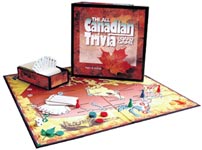 The
All Canadian Trivia Board Game should be the trivia game of choice
for Canadian parents and teachers. All questions relate to Canada with
a board featuring a map of our country, on which players move around collecting
tokens. The
All Canadian Trivia Board Game should be the trivia game of choice
for Canadian parents and teachers. All questions relate to Canada with
a board featuring a map of our country, on which players move around collecting
tokens.
The succinct questions are wide-ranging and implicitly instructive. They
are not concerned with the precise height of mountains, but ask for useful
bits of general knowledge applicable to everyday life. An example: "Name
both provinces whose names are derived from the Cree language" could
lead to an enlightening discussion of the contribution of aboriginal peoples
to our culture.
The game is made for two or more players, who can play individually or
in teams. The creators of the game recommend a minimum playing age of
12, but the questions are so wide ranging that there is something for
everyone. I wish this game had been available years ago for the children
in my Grade 3 and 4 classes who always finished their work early.
Since I'm not currently teaching young people I'm thinking of passing
on my review copy of the game to the retirement residence where I volunteer,
and where trivia games are popular to keep the residents' wits sharp.
They will love the fact that the game is All Canadian.
The All Canadian Trivia Board Game; Outset Media, Victoria, BC,
1997 (upgraded 2002); $39.99; tel 1-877-592-7374; fax 250-592-7522; www.outsetmedia.com
Ruth Latta is with the Ottawa Board of Education and teaches creative
writing to adults.
Melanie Bluelake's Dream
by Betty Dorion
Reviewed by Nadira Baksh
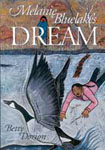 Melanie
is very angry with her mother for taking her away from her home, her kõhkom
(grandmother) and her friends at Elk Crossing. The story begins with a
sullen Melanie on the long ride to the city. She stabs her pencil at her
five-point list: Why I Hate My Mom. Melanie
is very angry with her mother for taking her away from her home, her kõhkom
(grandmother) and her friends at Elk Crossing. The story begins with a
sullen Melanie on the long ride to the city. She stabs her pencil at her
five-point list: Why I Hate My Mom.
Frances Bluelake is Melanie's young, single Cree mother. She lives with
her aging mother and her 10-year-old daughter in Elk Crossing, Saskatchewan.
She manages by working a couple of days a week at a store on the Cree
reserve, but that hardly makes ends meet and there is very little promise
for the future.
In Frances's attempt to make a better life for herself and her family,
she decides to move to the city to finish high school. She relocates with
Melanie to Prince Albert. It is not an easy decision for Frances. She
faces some disappointments with her school and work situations. In the
city they must live with friends, rely on the food bank and do without.
Frances feels embarrassed and frustrated with their circumstances but
resolves to complete her education. Frances's struggle is her daughter's
too, but for the 10-year-old, it's much different.
The novel traces Melanie's two months in the city. She misses everything
about her home and hates everything about the city. Starting school a
month late adds to her misery and she finds adjustment difficult. Determined
to be brave, she tries not to show her vulnerability. Even the lunch break
is intolerable. She resents having to eat lunch in the church hall where
food is provided for kids in need.
Melanie Bluelake's Dream is the first novel of Betty Fitzpatrick
Dorion. It's a nicely told, engaging story with a satisfying ending. Dorion
gives voice to the impressions of a strong-minded 10-year-old girl whose
resolve to remain furious with her mom wavers as she gains a deeper understanding
of the mother's goals and aspirations.
Melanie Bluelake's Dream; Coteau Books, Regina, 1995; ISBN 1-55050-081-3;
softcover, 214 pages, $4.95; tel 1-800-440-4471; Fax 306-522-5152; coteau@coteaubooks.com
Nadira Baksh is an elementary teacher who is currently on maternity
leave.
My "Teacher" Life
Why Make Your Own Mistakes When You Can Learn from Mine?
by Ingrid U. Hearn
Reviewed by Gianna Di Rezze
 Described
as a "non-fiction, educational, self-help book that gets up close
and personal" this book is Hearn's attempt to share some of the folk
wisdom gathered over a lifetime of teaching. Hearn's enthusiasm for her
work is evident as she describes experiences that have helped to define
what teaching and learning are for her. Through a series of personal vignettes
she offers advice on topics such as homework, overnight trips with students,
integrating drama into the classroom, the role of parents and building
self esteem, to name but a few. Described
as a "non-fiction, educational, self-help book that gets up close
and personal" this book is Hearn's attempt to share some of the folk
wisdom gathered over a lifetime of teaching. Hearn's enthusiasm for her
work is evident as she describes experiences that have helped to define
what teaching and learning are for her. Through a series of personal vignettes
she offers advice on topics such as homework, overnight trips with students,
integrating drama into the classroom, the role of parents and building
self esteem, to name but a few.
Throughout the book she cites persons as diverse as Napoleon Hill, Wayne
Gretzky and Yogi Berra. Highlighted in various font styles for emphasis,
the digressions are not terribly insightful and seem like unnecessary
asides to the topic at hand.
It is an ambitious task to distill thirty years of classroom teaching
wisdom. But Hearn's enthusiasm for teaching comes through easily and no
doubt the writing of this book benefited the author herself. Writing helps
clarify inchoate thoughts and feelings and is an important way of sense
making. Readers will decide for themselves what they will take away from
this book.
In answer to Hearn's subtitle Why make your own mistakes when you can
learn from mine? I would respond with her own words from the introduction
of this book. "The secret here is to always realize and accept your
mistakes. Be willing to learn from them."
Like all human enterprises the highly relational world of teaching assumes
we will all make some mistakes along the way. What we learn from our mistakes
is contingent on how deeply we reflect on these critical incidents and
the personal meanings that we attribute to them. Hearn's book is one example
of this lifelong process at work.
My "Teacher" Life; 1st Books Library, Bloomington, Indiana,
2002; ISBN 1-4033-8785-0; softcover, 232 pages, $25.00; www.myteacherlife.com
Gianna Di Rezze is a teacher with the Toronto Catholic District School
Board.
Lire et écrire
by Yves Nadon
Reviewed by Helen Donohoe
French only
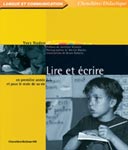 Written
from the heart, this text by Yves Nadon, a Grade 1 teacher in Québec,
outlines in great detail the reading and writing process of primary students.
It is a splendid balance of passionate writing and practical pedagogy. Written
from the heart, this text by Yves Nadon, a Grade 1 teacher in Québec,
outlines in great detail the reading and writing process of primary students.
It is a splendid balance of passionate writing and practical pedagogy.
With the bulk of the book devoted to the mechanics of getting young children
to begin to read and write, the author supplies immensely rich ideas and
observations. Ample examples show clearly how the students progress from
September to June. Nadon's meticulous analysis of each piece of student
writing can be applied universally.
It is heartening to note that various contemporary approaches to the
reading process - such as guided reading and shared reading - as well
as diagnostic tools (for example, the taking of running records as developed
by New Zealand educator Marie Clay) are used regularly in other parts
of the country. The process developed by Nadon for productive conferencing
with students about their work is particularly well outlined.
In the final chapter Nadon provides some of his own assessment techniques
but does not correlate them to marks or letter grades. This is the only
weakness in an otherwise extremely useful text for the primary teacher
in a French-language or French-immersion school.
The very comprehensive bibliography at the end of each chapter (most
of the texts listed are in English) allows readers to expand their own
range of knowledge, while the appendices contain useful ideas and charts
for checklists and assessment.
Lire et écrire; Chenelière-McGraw-Hill, Montréal,
2002; ISBN 2-89461-928-6; softcover, 184 pages, $32.95; tel 514-273-1066;
1-800-565-5531; fax 514-276-0324
Helen Donohoe is a recently retired French teacher with Hamilton-Wentworth
District School Board.
First Year Teacher's Survival Kit
Ready-to-Use Strategies, Tools & Activities for Meeting the Challenges
of Each School Day
by Julia G. Thompson
Reviewed by Jane Mawson
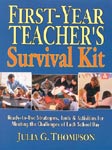 This
book is a valuable resource for those entering the profession or for those
who want to get back to the basics and re-learn some fundamentals. It
offers a wide range of helpful hints and forms that will help teachers
streamline their time and make the most of their teaching day. This
book is a valuable resource for those entering the profession or for those
who want to get back to the basics and re-learn some fundamentals. It
offers a wide range of helpful hints and forms that will help teachers
streamline their time and make the most of their teaching day.
The book is divided into 16 sections for easy reference. It starts off
logically with "Your New Vocation" and addresses topics such
as organizing and making the most of your time, being a valuable team
member, designing and delivering effective instruction, evaluation and
of course classroom management. The book winds down with "Stress
Management for Educators." It is written in a format that makes it
an excellent quick-reference guide. After reading the book one can easily
go back and remind oneself of a point or strategy of interest.
Having just completed my first year of teaching, I found much of this
book to be a review of what I learned at the Faculty of Education - not
a bad thing. It reminded me about good strategies for working with parents
and engaging my students and myself. It also gives suggestions that the
Faculty did not provide regarding dealing with peers, pitfalls of the
staff room and self-evaluation tools to determine where my strengths and
weaknesses lie as I enter the profession. Each section concludes with
suggestions for professional journal entries on the topic that has just
been covered. These encourage the reader to be reflective - a habit too
easily dropped.
Although written primarily for teachers in the U.S. the book covers general
material applicable to the Ontario system. Overall, The First-Year
Teacher's Survival Kit should be a welcome addition to any teacher's
professional library.
First Year Teacher's Survival Kit; Paramus, NJ, 2002; ISBN 0-13-0616443;
softcover, 472 pages, US$29.95; produced by the Center for Applied Research
in Education; tel 201-909-6484; fax 201-909-6378; Lara.Rodriquez@pearsoned.com
Jane Mawson is a teacher with the Durham Board of Education.
The Small Worlds Series
by James W.R. Martin and Jen Green
Reviewed by Karen Champagne
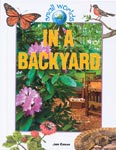 This
delightful series takes children on a journey to various habitats, exploring
how plants and animals live together in small environments. All 10 books
are beautifully bound and contain stunning photographs that are sure to
engage readers. This
delightful series takes children on a journey to various habitats, exploring
how plants and animals live together in small environments. All 10 books
are beautifully bound and contain stunning photographs that are sure to
engage readers.
Each book has a table of contents followed by a one-page description
outlining the main idea and a geographical map (where appropriate). The
following two pages are a wonderful visual aid as well as an informative
guide, showing where animals and plants can be found in their habitat.
The authors include Fantastic Facts sections throughout, as well as environmental
concerns and tips for getting to know more about the animals and plants.
The last page offers "words to know" as well as an index to
all animals and plants mentioned.
These books are informative, visually appealing and very easy to read.
They would be a wonderful addition to any school library.
The Small Worlds Series consists of In a Backyard, A
Coral Reef, A Dead Log, A Freshwater Pond, A Rainforest
Tree, A Saguaro Cactus, On the Tundra, A Tidal Pool,
Under a Stone and In a House; Crabtree Publishing, St. Catharine,
ON, 2002; 32 pages, hardcover $19.96, softcover $9.86; tel 1-800-387-7650;
fax 1-800-355-7166; letters@crabtree-pub.com
Karen Champagne teaches at St. Mildred's-Lightbourn School in Oakville.
Vivre le conte dans sa classe
Pistes de découverte et exploitations pédagogiques
French only
by Charlotte Guérette and Sylvie Roberge Blanchet
Reviewed by Véronique Ponce
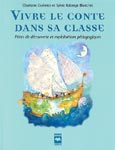 If
you are sometimes short of ideas for organizing original activities that
foster both the joy of reading and the development of various skills,
this is the tool for you. The authors are full of suggestions for extremely
well thought out and very detailed activities. If
you are sometimes short of ideas for organizing original activities that
foster both the joy of reading and the development of various skills,
this is the tool for you. The authors are full of suggestions for extremely
well thought out and very detailed activities.
Each of the six chapters covers a topic that will capture children's
attention, such as the history or art of storytelling. The chapters are
divided into numerous subsections that guide the reader to study aspects
of the stories presented. The stories were chosen based on predetermined
educational outcomes: developing self-confidence, introducing rules for
living, tapping into creativity and exercising critical judgement, to
name just a few.
The authors hold your hand through each activity - suggesting, for example,
the best way to present a story, the best time to turn the page, what
tone to adopt and possible activities to encourage discussion, as well
as gestures and songs that go well with the stories. They briefly cover
the psychological and affective characteristics of various age groups
(seeking security and fearing the unknown, for example).
This book is a valuable source of bibliographical information and educational
activities. It gives links between the stories used and other disciplines,
such as moral instruction, art, science and technology. Although the book
is linked to the Québec curriculum, Ontario teachers will find
it contains enough ideas and material to inspire them for the rest of
their careers.
Vivre le conte dans sa classe; Éditions Hurtubise HMH,
Montréal, 2003; ISBN 2-89428-619-8; softcover, 222 pages, $32.95;
tel 514-523-1523; 1-800-361-1664; fax 514-523-9969; www.hurtubisehmh.com
Véronique Ponce is a translator-editor at the Ontario College
of Teachers.
Des idées fraîches à l'école
Activités et projets pour contrer les changements climatiques
French only
Edited by Tim Grant and Gail Littlejohn
Reviewed by Pierre Drouin
 Making
our young people aware of the problem of climate change is a daunting
challenge. Des idées fraîches à l'école
makes the teacher's task easier. Making
our young people aware of the problem of climate change is a daunting
challenge. Des idées fraîches à l'école
makes the teacher's task easier.
The articles in this collection are divided into different topics. Each
two- to five-page article presents a theoretical aspect of climate change
and hands-on activities that appeal to students' sense of observation
and critical interest. Des idées fraîches à l'école
includes activities, projects and simple teaching tools on biodiversity,
agriculture, population growth, the greenhouse effect, transportation,
energy choices and so on that can readily be used by elementary and secondary
school students. Ideas include experiments on the properties of gases
and electricity storage, a survey on transportation, an exploration into
the actual cost of vehicles, and advice on how to make peanut butter or
build a solar cooker.
The collection also lists a number of resources, including organizations
that can provide support in relevant areas (the environment, energy efficiency,
alternative transportation), a bibliography and a list of Internet sites.
A list of activities by age groups (5-8, 9-11, 12-14, 15-17) provides
multidisciplinary links (science and technology, mathematics, French,
visual arts, geography, drama).
Des idées fraîches à l'école is a resource
book on a topic of current interest that is chock full of activities and
research topics, which are bound to stimulate students' natural curiosity
by encouraging them to ask questions, examine the impact of certain current
practices on the environment and come up with alternative solutions.
Des idées fraîches à l'école; translated
and adapted by ERE Éducation, Éditions Multimondes and Green
Teacher, Toronto, 2001; ISBN 2-89544-017-4; softcover, 80 pages, $15.95;
tel 416-960-1244; fax 416-925-3474; www.greenteacher.com
Pierre Drouin is a part-time professor at the Faculty of Education
of the University of Ottawa.
Chase a Rainbow
CD by Kidz Kidding
Reviewed by Margaret Buckworth
Three music teachers from Toronto got together and formed the Just Kidding
Band. (They are also known as Kidz Kidding - which is confusing.) The
Unionville High School choir guests on this CD. Being teachers they have
conveniently made a book with the words to the songs, curriculum content,
reproducible activities and lesson plans.
I introduced the CD to my classroom on Earth Day. We learned the song
Earth Bop. The lyrics were appropriate but the rock style wasn't a hit
with my kindergarten classes. Too young? Though the introduction does
say this CD is for early and primary years.
The song that really moved them was Snap, Clap, Trap. As the CD has a
wide variety of musical styles every child or teacher should be able to
find one to their taste.
Chase a Rainbow, CD, $18.95; 4261-A14 Hwy, #7, Suite 257, Unionville,
ON L3R 9W6; www.kidzkidding.com
Margaret Buckworth is a Kindergarten teacher at Red Maple Elementary
School in Richmond Hill.
|

